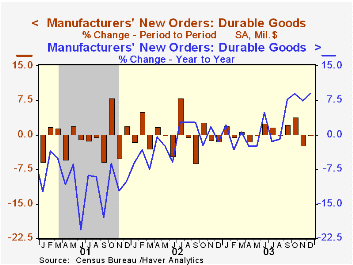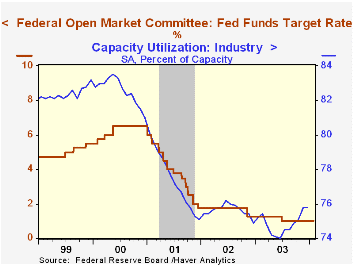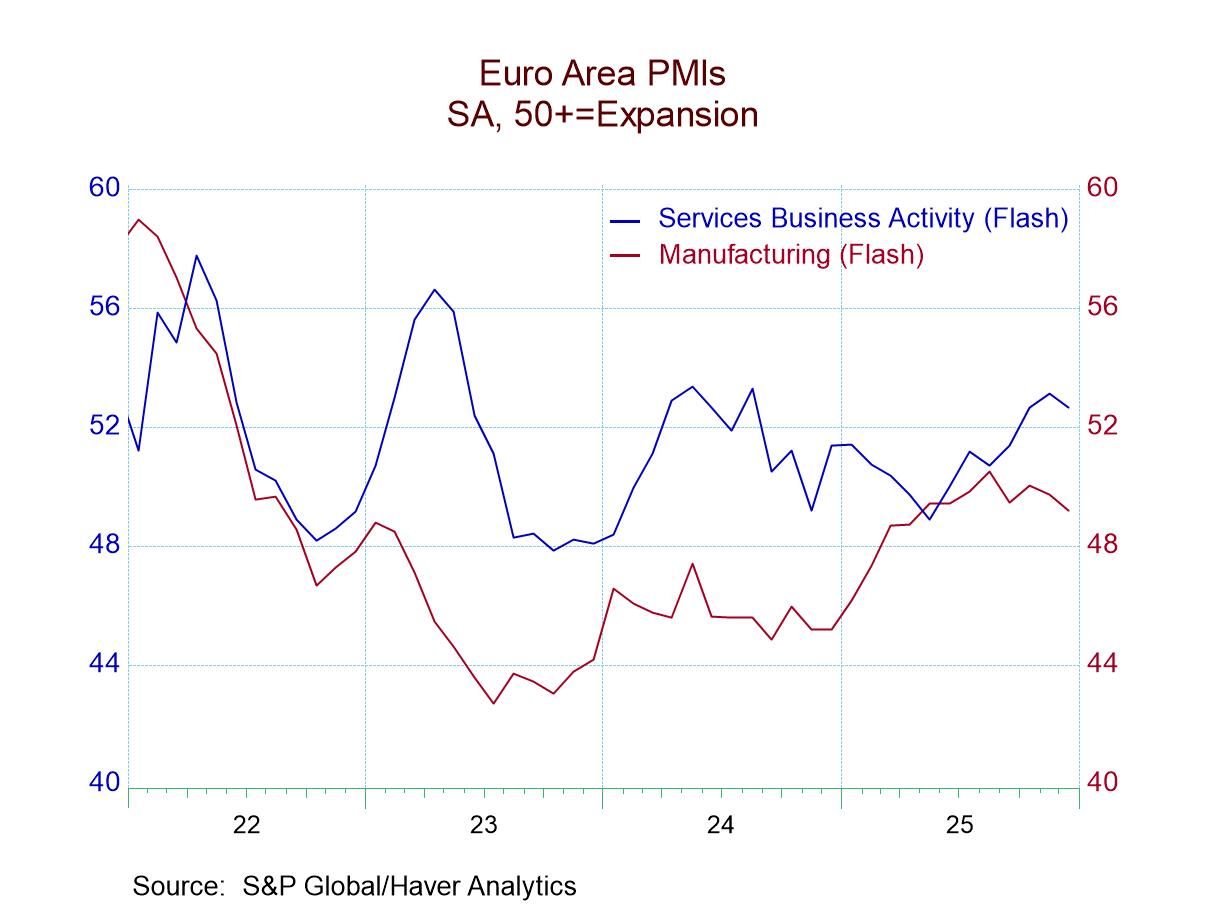 Global| Jan 28 2004
Global| Jan 28 2004U.S. Durable Goods Orders Flat
by:Tom Moeller
|in:Economy in Brief
Summary
Durable goods orders were roughly unchanged last month. The previously reported 3.1% plunge in November orders was lessened to a 2.3% drop. Consensus expectations had been for a 2.0% rise in December orders. Weaker orders in the [...]

Durable goods orders were roughly unchanged last month. The previously reported 3.1% plunge in November orders was lessened to a 2.3% drop. Consensus expectations had been for a 2.0% rise in December orders.
Weaker orders in the technology sector has been behind much of the recent orders' weakness. Orders for computers & electronic products fell 2.7% (+6.6% y/y) following a 12.2% November drop. Orders for communication equipment plunged 18.1% following a 46.4% November skid that was downwardly revised (-10.6% y/y). Orders for computers and related products rose 2.0% (9.1% y/y).
Orders for electrical equipment, appliances & components fell 0.5% (-1.1% y/y) after a 2.2% November decline.
Excluding the volatile transportation sector durable goods orders fell 0.7% following a 3.2% November decline. Orders for transportation equipment rose 1.4% (+14.4% y/y) on the strength of a 25.5% rise in orders for nondefense aircraft.
Nondefense capital goods orders excluding aircraft and parts fell another 0.4% following a 5.6% November drop (+9.4% y/y).
Shipments of durable goods rose 0.6% (+7.2% y/y). Excluding transportation shipments rose 0.9% (6.2% y/y). Shipments of machinery have been strong.
Durable inventories rose 0.2% (-3.6% y/y) for the second gain in three months.
| NAICS Classification | Dec | Nov | Y/Y | 2003 | 2002 | 2001 |
|---|---|---|---|---|---|---|
| Durable Goods Orders | -0.0% | -2.3% | 8.9% | 2.4% | -1.7% | -10.5% |
| Nondefense Capital Goods | 0.2% | -6.0% | 8.0% | 5.3% | -7.2% | -15.5% |
by Tom Moeller January 28, 2004

Sales of new single family homes fell 5.1% to 1,060M in December, down for the fourth month since the peak in June. Since then sales have fallen 11.7%. Consensus estimates were for a lesser decline to 1.100M.
Sales were mixed across the country; up in Northeast and in the Midwest but down elsewhere.
The median price of a new home fell 3.3% m/m to $197,600 (0.0% y/y).
These new home sales data from the US Census Department reflect current sales versus the existing home sale figures which reflect closings on past sales.
| Homes Sales (000s, AR) | Dec | Nov | Y/Y | 2003 | 2002 | 2001 |
|---|---|---|---|---|---|---|
| New Single-Family | 1,060 | 1,117 | 0.8% | 1,086 | 977 | 907 |
by Tom Moeller January 28, 2004

The index of mortgage applications compiled by the Mortgage Bankers Association slipped 5.2% last week following a 30.4% spike the week prior.
Applications to refinance fell 0.9% after a 51.5% leap the prior week.
Purchase applications fell 10.0% w/w but still are up 9.9% so far in January versus December.
During the last ten years there has been a 54% correlation between the y/y change in purchase applications and the change in new plus existing home sales.
The effective interest rate on a conventional 30-Year mortgage rose slightly to 5.87% from 5.82% the prior week. The effective rate on a 15-year mortgage rose to 5.20%.
The Mortgage Bankers Association surveys between 20 to 35 of the top lenders in the U.S. housing industry to derive its refinance, purchase and market indexes. The weekly survey accounts for more than 40% of all applications processed each week by mortgage lenders. Visit the Mortgage Bankers Association site here.
| MBA Mortgage Applications (3/16/90=100) | 1/23/04 | 1/16/03 | 2003 | 2002 | 2001 |
|---|---|---|---|---|---|
| Total Market Index | 868.9 | 916.1 | 1,067.9 | 799.7 | 625.6 |
| Purchase | 451.6 | 501.6 | 395.1 | 354.7 | 304.9 |
| Refinancing | 3,296.7 | 3,327.3 | 4,981.8 | 3,388.0 | 2,491.0 |
by Tom Moeller January 28, 2004

As expected, the Federal Reserve left the target rate for federal funds unchanged at 1.00%. The discount rate also was left unchanged at 2.00%.
The decision was unanimous.
The press release which accompanied the Fed’s action was similar to prior communiqués but also indicated that "Although new hiring remains subdued, other indicators suggest an improvement in the labor market."
The press release eliminated the statement suggesting that policy accommodation could be maintained for a "considerable period." Most economists expected this elimination at the last FOMC meeting. However, the latest statement concluded by indicating that "With inflation quite low and resource use slack, the Committee believes that it can be patient in removing its policy accommodation."
The complete text of the Fed's latest press release can be found here.
Analysis titled "Monetary Policy and the Zero Bound: Policy Options When Short-Term Rates Reach Zero" from the Federal Reserve Bank of Kansas City is available here.
Tom Moeller
AuthorMore in Author Profile »Prior to joining Haver Analytics in 2000, Mr. Moeller worked as the Economist at Chancellor Capital Management from 1985 to 1999. There, he developed comprehensive economic forecasts and interpreted economic data for equity and fixed income portfolio managers. Also at Chancellor, Mr. Moeller worked as an equity analyst and was responsible for researching and rating companies in the economically sensitive automobile and housing industries for investment in Chancellor’s equity portfolio. Prior to joining Chancellor, Mr. Moeller was an Economist at Citibank from 1979 to 1984. He also analyzed pricing behavior in the metals industry for the Council on Wage and Price Stability in Washington, D.C. In 1999, Mr. Moeller received the award for most accurate forecast from the Forecasters' Club of New York. From 1990 to 1992 he was President of the New York Association for Business Economists. Mr. Moeller earned an M.B.A. in Finance from Fordham University, where he graduated in 1987. He holds a Bachelor of Arts in Economics from George Washington University.






